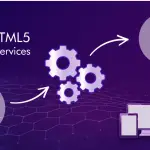The Future of Flash to HTML5 Conversion: Trends and Predictions
The rise of the internet has revolutionized the way we consume content. From videos to animations and interactive applications, the web has become a hub of immersive experiences. Flash has been a popular technology for web developers to create these experiences for more than two decades. However, with the rise of HTML5, Flash has become an outdated technology that is no longer supported by major browsers. This has led to the need for Flash to HTML5 conversion services. In this article, we will discuss the future of Flash to HTML5 conversion, trends, and predictions for the industry.
Flash to HTML5 Conversion: The Need of the Hour
HTML5 is a modern web standard that is more versatile, accessible, and faster than Flash. HTML5 supports rich multimedia content such as videos, audio, and animations without the need for plugins. HTML5 is also more compatible with mobile devices and offers better security features. Given these benefits, it is no surprise that many businesses and developers are looking to convert their existing Flash content to HTML5.
According to a report by Grand View Research, the global HTML5 market size is expected to reach $227.3 billion by 2025, growing at a CAGR of 17.5% during the forecast period. This growth is driven by the increasing demand for rich media content, cross-platform compatibility, and mobile-friendly web design.
Trends in Flash to HTML5 Conversion Services
The Flash to HTML5 conversion industry is constantly evolving, and new trends are emerging. Let’s take a look at some of the major trends in the industry.
1. Automation Tools
The conversion process can be time-consuming and labor-intensive. To make the process more efficient, many service providers are using automation tools. These tools can analyze the existing Flash content and automatically generate HTML5 code. This not only speeds up the conversion process but also reduces the risk of errors.
2. Responsive Design
With the increasing number of mobile users, responsive design has become a critical aspect of web design. Many service providers are focusing on creating HTML5 content that is optimized for mobile devices. They are using responsive design techniques to ensure that the content looks good and functions well on screens of all sizes.
3. Accessibility
Accessibility is an important consideration for web developers. HTML5 offers better accessibility features than Flash, such as support for alt tags, captions, and transcripts. Many service providers are ensuring that their HTML5 content meets accessibility standards, making it easier for users with disabilities to access and interact with the content.
Predictions for the Future
The Flash to HTML5 conversion industry is poised for significant growth in the coming years. Here are some predictions for the future of the industry.
1. Increased Demand
As more businesses and developers realize the benefits of HTML5, the demand for Flash to HTML5 conversion services will continue to increase. This growth will be driven by the need to update existing Flash content to HTML5, as well as the demand for new HTML5 content.
2. Emergence of New Technologies
The industry is likely to see the emergence of new technologies that make the conversion process even more efficient and accurate. For example, machine learning algorithms could be used to analyze and convert Flash content automatically. Augmented reality and virtual reality technologies may also be integrated into HTML5 content, creating even more immersive experiences.
3. Integration with Emerging Technologies
HTML5 is a versatile technology that can be integrated with other emerging technologies, such as artificial intelligence and the Internet of Things (IoT). This integration could lead to the creation of innovative applications that offer personalized, context-aware experiences.
Conclusion
The future of Flash to HTML5 conversion is bright, with significant growth opportunities and emerging trends. As businesses and developers continue to embrace HTML5, the demand for conversion services will continue to increase.

